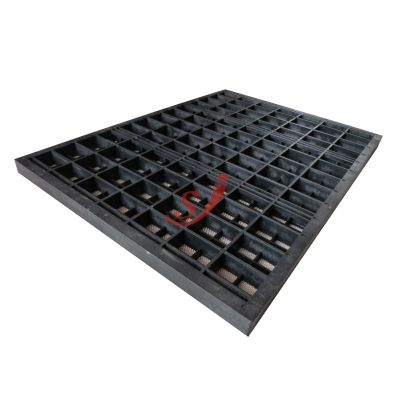As the main vulnerable part of the vibrating screen, the screen mesh is in direct contact with the material during the production process. Once the material is not selected properly, it is easy to be damaged too quickly. At present, the materials of the screen mesh are mainly divided into two types: metal and non-metal. Metal materials include low carbon, high carbon, high manganese steel, stainless steel, etc., and non-metal materials are mostly rubber, nylon, polyurethane, etc. In order to facilitate everyone to make the right choice, this article introduces the performance characteristics of several commonly used screen meshes in the mining industry.
High manganese steel screen mesh
Among the many materials, the high manganese steel screen mesh is the most reliable in quality. It is a screen mesh product woven with manganese steel wire with a wire diameter of 1.6mm-12mm. It adopts an embedded weaving method, the warp and weft overlap points are not prominent, the screen surface is flat, the force is uniform, it has good plasticity and toughness, and can achieve better use effects. At the same time, the service life is more guaranteed.
High manganese steel has high strength, rigidity and load-bearing capacity. When subjected to strong impact and friction, the surface undergoes strong work hardening due to plastic deformation. The surface hardness value can be increased to above HRC60, thereby obtaining higher wear resistance, while the interior still maintains high plasticity and toughness.
In addition, when the old surface is worn, a wear-resistant layer will be formed on the new surface, so the service life can reach 4-8 times that of ordinary screens.
Polyurethane screen
Polyurethane screen is also a relatively easy-to-use and wear-resistant one. Polyurethane itself has a very high elastic modulus, high strength to absorb impact, high wear resistance, and high tensile strength. Therefore, its load-bearing capacity is higher, which is more than 2.5 times that of rubber screen plates. The service life is 8-10 times higher than that of ordinary metal screen plates, 3 times that of stainless steel screen surfaces, and 3.9 times that of natural rubber. It is currently the screen surface material with better wear resistance.

The production material of polyurethane screen is a high molecular organic elastomer, which has excellent wear resistance, flexibility resistance, large load-bearing capacity, and has undergone special treatment to ensure that it will never delaminate under long-term alternating loads.
Stainless steel screen
The main materials of stainless steel screen are 201, 201, 302, 304, 304L, 316, etc., with the following characteristics:
Good acid resistance, alkali resistance, and rust resistance;
High strength, strong tension, toughness and wear resistance, and durable;
Suggested reading:High temperature oxidation resistance, the nominal temperature resistance of 304 stainless steel screen is 800℃, and the nominal temperature resistance of 310S stainless steel screen can reach 1150℃;
Normal temperature processing, that is, easy plastic processing, makes the use of stainless steel screen diverse;
High finish, no surface treatment is required, and maintenance is convenient and simple.
Stainless steel screen is often used for screening and filtering under acid and alkaline environment conditions.
Welded screen
Welded screen is welded from high manganese steel raw materials. The raw materials are the same but the processing technology is quite different. It is introduced here separately because this type of screen is widely used.
High manganese steel has a brittle temperature range of carbide precipitation between 250~800℃, and cast high manganese steel also has network carbides and casting stress, so the welding performance is very poor.
For high manganese steel castings, the riser should be cut or the defects should be welded after water toughening treatment, and the welding should be cooled quickly. In order to eliminate or minimize the heat affected zone, a small current should be used, discontinuous welding should be performed, or water should be poured while welding to cool. The welding rod should be a high manganese steel welding rod or an austenitic stainless steel welding rod. If there is a work hardening layer, it should be removed before welding.
Perforated screen
Perforated screen refers to a screen that uses a punch press to punch out the target pattern in the plate to be processed. It is generally made of stainless steel, aluminum plate, hot and cold steel plate, copper plate, PVC plate film and other materials. There are many hole types to choose from, including long holes, square holes, round holes, hexagonal holes, fish scale holes, stretched special-shaped holes, etc.
Perforated screen has the characteristics of light weight, non-slip, beautiful appearance, good filtering performance, etc. It is often used in environmental noise control barriers in transportation and municipal facilities, grinding screens, mine screens, I-shaped screens, etc. used in mines.
The material of the Replacement Shaker Screen is a point that many users will focus on when choosing a vibrating screen, because this is largely related to the service life of the equipment and the subsequent cost investment. Once the choice is improper, it will accelerate the wear of the screen, affect normal production, and increase the cost of components. Therefore, users must pay attention when choosing the material of the screen, and try to choose wear-resistant and good products.

Comments
0Related Articles
By Geym
331
0
0
By Geym
229
0
0
By Ingrid
273
0
0
By Geym
228
0
0
By Geym
157
0
0
By May
148
0
0
By Evelyn
130
0
0
By wenzhang1
128
0
0